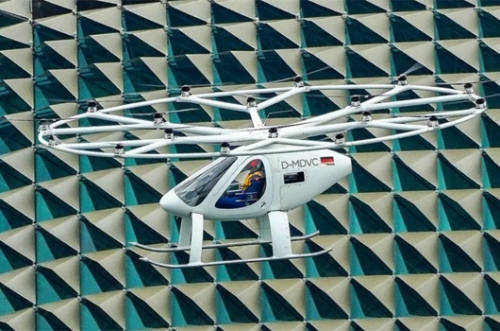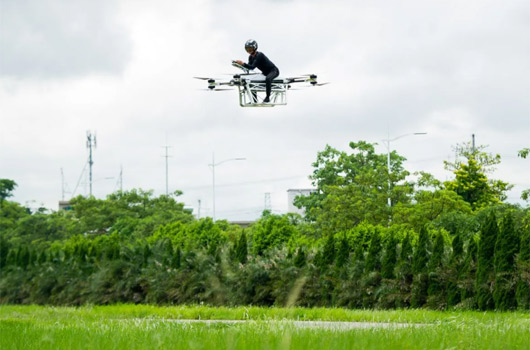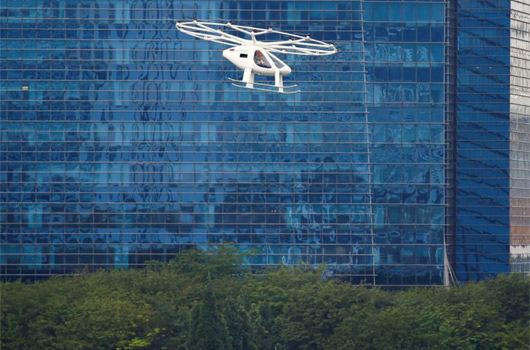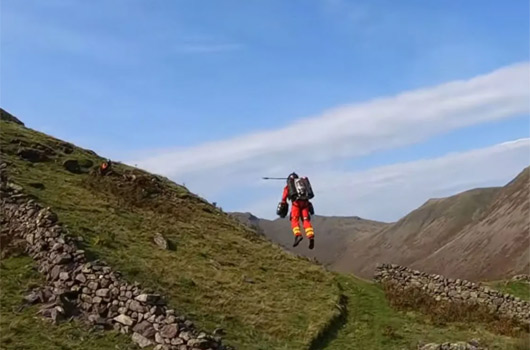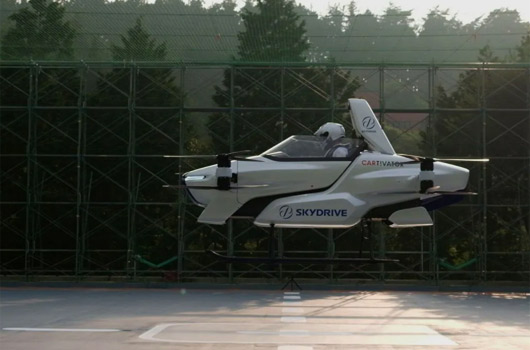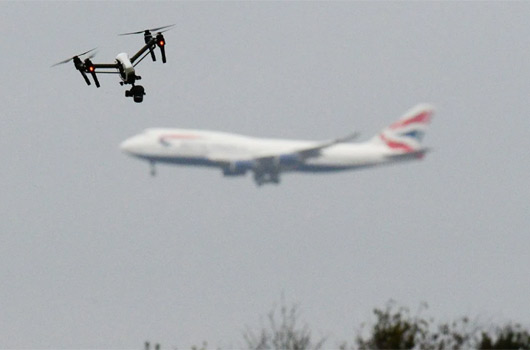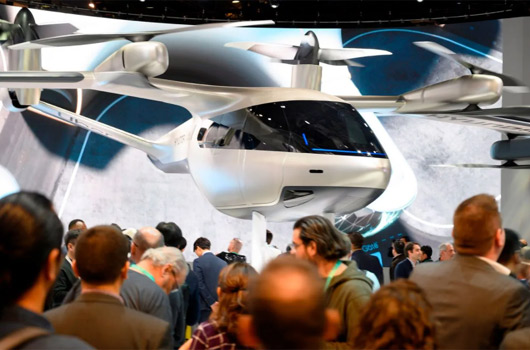The flying car is here – and it could change the world
BBC | Washington
The Daily Tribune – www.newsofbahrain.com
The original Blade Runner film took place in an imagined Los Angeles of 2019, a futuristic city where acid rain fell from skies crowded with “skimmers”: flying cars that zipped along aerial highways. Since the film’s 1982 debut, technology has advanced in ways that Hollywood might never have predicted – selfie sticks, murder drones, hashtag politics – yet hovercraft taxis still seem a far-off fantasy, reserved for science-fiction novels and theme park rides.
In fact, flying cars are real – and they could shape how we commute, work and live in the coming decades. Advances in battery energy density, materials science and computer simulation have spurred the development of a range of personal flying vehicles (and the navigation systems that will allow them to run), from electric gliders to fixed-wing craft and quadcopter drones.
These aircraft may not look exactly like Blade Runner’s imaginings. But they aren’t all that far off. Far smaller than a commercial plane, most are designed with rotors instead of wings, which allow for vertical takeoff and landing. Tilt rotors, for example, allow for efficiency in forward flight at longer distances, while multirotors are designed to reduce noise in hover flight. Most important, these vehicles are designed to offer faster commutes than traditional modes of transit for individuals, especially in traffic-clogged cities.
At the moment, the autonomous urban aircraft market is still a bit of a Wild West. Dozens of start-up companies are competing to develop commercial jetpacks, flying motorbikes and personal air taxis. Venture capitalists, auto and aviation corporations (even rideshare company Uber, with its ambitious Uber Elevate) are staking claims on the burgeoning industry, which may be worth as much as $1.5tn (£1.1tn) by 2040. Meanwhile, aviation authorities hash out the policies and safety standards that will govern this new realm of transport.
Germany-based Volocopter, for instance, has marketed its VoloCity craft as the first commercially licensed electrically powered air taxi, a vehicle which will eventually run without a pilot. “It’s like an Uber Black or any other premium service,” says Fabien Nestmann, vice president of public affairs at Volocopter.
With a few key differences, that is. Initially, the VoloCity will only have room for a single passenger. That will mean a higher cost per ride at first, but Volocopter hopes to build consumer confidence before transitioning to a full-autonomy model: an electric, wingless craft powered by nine batteries, which will transport passengers throughout a planned network of vertiports – airports for planes that take off and land vertically – across major cities. VoloCity’s first commercial flights are scheduled to take place in 2022.
These first flights will cost €300 ($350/£270) per ticket. But eventually, says Nestmann, the company’s goal is to make the cost competitive with, say, an Uber Black. “We don’t want this to be a toy for the wealthy, but part of a well-integrated journey for anyone in an urban area,” he says. “Everyone should have the option to walk, be driven, cycle, or fly.”
Other companies have partnered with existing car manufacturers to create models they plan to develop for eventual commercial use. Japanese startup SkyDrive, for example, recently teamed up with Toyota to conduct a test flight of its all-electric air taxi, said to be the world’s smallest electric vehicle that can take off and land from a vertical position.
This summer, the company successfully flew its SD-03 craft for several minutes around an airfield with a pilot at the helm.
“Consumer demand has grown, but humans have not yet provided a clear solution to traffic, even through options like electric cars or speedy alternatives like [France’s intercity] TGV train,” says SkyDrive representative Takako Wada. “You could say SkyDrive mobility has been nurtured by consumption demands as well as by advances in technology.”
Indeed, those advances makes it possible for so many aircraft designers to clamour for airtime, as it were. Companies like Lillium, Wisk, Joby Aviation, Bell and countless others are capitalising on innovations like electric propulsion, which dramatically reduces noise emissions, and battery power, which enhances range. For an industry in its infancy, there are no shortage of Vertical Take Off and Landing (VTOL) designs, or the imaginary heights that might be reached with them.
Consider Gravity Industries, a UK-based aeronautical company that created a 1,050-horsepower wearable jetpack. “It’s a bit like a Formula One car,” says Richard Browning, chief test pilot and founder of the company. “The Jetsuit is a specialist piece of equipment that only trade professionals and military fliers can ride, for now.” Browning gestures to a metallic, Batman-esque contraption in his studio. “Someday, the jetpack might mean a hovering super hero paramedic can make decisions about where to go and what to do.”
This is not as pie-in-the-sky a scheme as it sounds: the Great North Air Ambulance Service recently partnered with Gravity Industries to simulate a search and rescue mission. Browning flew in his jetpack from the craggy valley bottom of Langdale Pikes in England’s Lake District to a staged casualty site. By foot, it would have been a 25-minute arduous climb.
The flight took 90 seconds. The exercise illustrated the potential of jetpacks to deliver critical care services to remote locations.
“The dream of air transport has been around for a long time,” says Parimal Kopardekar, director of Nasa’s Aeronautics Research Institute at the Ames Research Center in Silicon Valley, California. “There’s a powerful opportunity now to design vehicles that can transport goods and services where current aviation can’t reach.”
Kopardekar is responsible for exploring aviation trends in autonomy and advanced air mobility, including VTOLs. Given the complexity of this undertaking, the team at Nasa must address and test an entire ecosystem of factors: aircraft, airspace, infrastructure, community integration, weather patterns, GPS, noise standards, maintenance, supply chain, parts acquisition… It’s a list that reveals numerous and not always obvious problems that must be resolved before aerial ridesharing at scale can become a reality.
Reimagining human flight requires vehicles that are “road legal” and safe to fly, but also a public willing to fly in them. Industry leaders need to convince riders that VTOLs aren’t compelling simply because the technology is possible, but because it is preferable to other modes of transport – and safe.
“You cannot offer commercial services without extremely vigorous testing regimes,” says Nestmann, who oversees Volocopter’s public education initiatives. “Part of that is developing the infrastructure for these machines.” That might mean hardware construction of vertiports and storage facilities equipped with electrical power, or software run behind the scenes: systems needed to run VTOLs will undoubtedly require near-full automation to properly coordinate the envisioned swarms of vehicles. While the commercial aircraft we travel on today are monitored by human controllers in a tower, the flying machines of tomorrow will rely on UTM: Unmanned Traffic Management. This digital tracking will ensure that all VTOLs have common awareness of other flights in their path.
Fully automated vertical transport with a proven track record may put the public at ease, but a vast network of flying objects creates a host of new challenges. VTOLs will obviate the need for runways or on-the-ground parking, but they will require dedicated air corridors and sky-harbours to store craft. Air taxis might reduce the number of cars on the ground and enhance arrival and departure time predictability, but the sheer number of objects in the sky – buildings, birds, delivery drones and airplanes – will require pilots (at least, while VTOLs are piloted) to practise a new kind of dynamic obstacle avoidance. The “Skyway”, for want of a better term, will need its own set of laws.
Additionally, manufacturers and operators will have to show that no harm will come either to passengers or to people on the ground below. In concert with the US’s Federal Aviation Administration and other regulatory bodies, Kopardekar and the team at Nasa created an “Urban Air Mobility Maturity Levels Scale”, which ranks craft, airspace and other systems on a scale of one to six based on complexity and urban density. They are devising ways to simplify cockpit operations, with a combination of automation and contingency management: guidelines for how a VTOL might respond to bad weather, bird strike, or sudden jetpack intruder, for example.
Already, incidents have shown the importance of these types of guidelines: in October 2020, crewmembers on a commercial airliner near LAX airport in Los Angeles spotted a jetpack at 6,000 feet (1,828m) – an altitude that presents serious risk of collision.
The European Aviation Safety Agency (EASA) has also created a set of technical specifications for VTOLS, though the agency hasn’t quite decided how to certify them. These specifications aim to address the unique characteristics of flying cars, and detail airworthiness standards like emergency exits, lightning protection, landing gear systems and pressurised cabins. “Despite having design characteristics of aeroplanes, rotorcraft or both,” EASA’s statement reads, “in most cases EASA was not able to classify these new vehicles as being either a conventional aeroplane or a rotorcraft.” In other words, EASA seems undecided about what, exactly, separates VTOLS from fixed-wing commercial jets or helicopters. Clearly, the successful operation of VTOLs will require coordinated efforts across sectors, including government, technology, transportation, urban planning and public outreach.
What accounts for the sudden proliferation of VTOL developers? Global trends like the rise of e-commerce, climate change, the gig economy and an integrated supply chain have accelerated interest in personal air travel, while failures in our current infrastructure and related industries underscore its necessity. As cities like New York, Hong Kong and Beijing reach capacity, urban living becomes less and less sustainable – yet our increasingly interconnected economy demands constant mobility.
The effects could transform commuting, and living, as we know it. “Right now, most people optimise living based on access to transportation,” notes Kopardekar. “VTOLs and drones will make it possible to reach people wherever they are, to optimise transportation based on living.” Businesses will no longer have to look to central business districts for their headquarters, while employees may choose to live anywhere within reach of an air taxi. Owning a VTOL could become as affordable and ubiquitous as owning a bicycle.
“On the macro level, ever-growing cities create a growing mobility need from the citizens in those cities,” says Nestmann. “That leads to a rethinking of the city, because building everything around the car doesn’t improve life quality.”
Traffic bottlenecks wear down our cities’ highways and the cars we drive on them, contributing to emissions that in turn threaten our planet’s delicate ecosystems and our own health. Meanwhile, eVTOLS (which are electric) will dramatically reduce emissions or reliance on diesel fuel.
increasing numbers of flying cars will naturally give rise to a changing layout in the way our cities are structured as cities grow taller, rooftop landings expand and air highways connect super sky-scrapers, freeing up space below. Fewer cars on the ground will reduce congestion and may give rise to parks and green spaces. “In the long run – 2045 and onward – businesses and green spaces will become much more integrated,” says Kopardekar. “While we may not ever eliminate metros and roads, we might be able to reduce their footprint with these machines.”
VTOLs have vast implications for the future of transport, work-life, consumption, urban design, even healthcare and ecology. As soon as 2030, consumers might be able to press a button and order an air taxi straight to their cloud-tethered office. In the decades that follow, we may ultimately have fewer and fewer reasons to descend to the earth below, conducting our business and our lives atop a city in the sky.
“One mile of road can only take you one mile,” says Kopardekar. “One mile of aviation can take you anywhere.”
Related Posts

